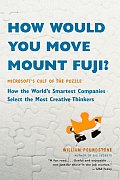 by William Poundstone
by William Poundstone
Puzzle: You’re responsible for hiring a team. They need to work well together, respond to changing business conditions, solve problems. You have one hour to interview each candidate. What questions will you ask them? Think about it before answering. There is no time limit.
Twenty years ago, the answer was obvious. Ask the prospect about his experience, about his plans, and then call his prior employer and find out if the guy’s worth it, or a deadweight who’ll spend his time running the office football pool. Round about the time people started suing over bad references, they also started writing down answers to the traditional interview questions on notecards. Employers came up with “behavioral” questions, asking people to describe their past work experiences. Since the expected answers were paragraphs, rather than sentences, it took a little longer for people to figure those out.
Then, two things happened. First, businesses (read: Microsoft) realized that they were hiring people for what they could do, not for what they had done. They had to be able to solve problems, not just apply formulas. Second, researchers figured out that people make their basic judgments about other people in the first two seconds. Two Seconds. Everything that comes after that, in a traditional interview, serves to validate that impression. Which means they aren’t worth much.
In the absence of now-illegal IQ testing, how do you test a prospective employee’s ability to solve problems? Why, give them problems to solve! Poundstone identifies three different types of problems: design problems, impossible problems, and puzzles. Puzzles tend to be variations of logic problems from 50 or 100 years ago. (My favorite: you have a closed room and three switches. With 10 minutes, and only one visit to the room, find out which switch controls the room’s light.) Impossible problems ask you to estimate the number of ping-pong balls you can fit in a 747, or how long it would take to move Mt.Fuji. Design problems ask you to design, say, VCR controls.
The point of all these questions is to give the interviewer insight into how the applicant solves problems under pressure. Is he persistent? Does he ask questions or make assumptions? Does he have enough wits even to know what the assumptions are? Puzzles have answers, impossible problems have approximate answers, and design questions have only processes. But the point of all of them, in theory, is to look at thought processes.
Do they help? Depends on what you’re really measuring? Almost all of the problems are math-oriented or algorithmic. They ignore fundamentals of human psychology in favor of Perfectly Logical Beings. So they might be better-suited to programming or finance types than to managers or planners. Also, some companies have rather rashly taken to making the interview itself a puzzle, playing games like having the interviewers not introduce themselves, or pretend to fall asleep. What this tells them about the applicant is anyone’s guess.
Poundstone doesn’t mention the popularity and usefulness of other testing. If you’re hiring someone to program in a specific language, for instance, it couldn’t hurt to look for certification. As for personality, with credit checks, background checks, legal checks, driving records, VCR/DVD rentals, library records, companies hardly need to subject people to the increasingly popular psychometric exams. Big Brother’s not only watching you, he’s hiring you.
The great fun of the book is the large number of puzzles Poundstone puts in. The Impossible Questions get old after about one, since they’re all variations on the same theme. The Puzzles are more fun, since they actually have answers.
Just be careful how you answer them. Or how you use them.
Answer to Puzzle: Turn on Switch #1 for 10 minutes, and then turn it off. Turn on Switch #2. Check the room. If the bulb is on, then it’s Switch #2. If the bulb is off, but hot, then it’s Switch #1. If the bulb is off and cold, then it’s Switch #3/